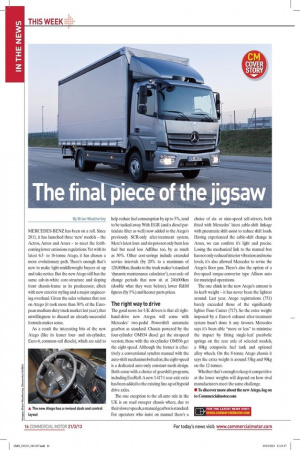The final pieN of the jigsaw By Brian Weatherley MERCEDES-BENZ
Page 10

If you've noticed an error in this article please click here to report it so we can fix it.
has been on a roll. Since 2011, it has launched three 'new' models — the Actros, Antos and Arocs — to meet the forthcoming lower emissions regulations. Yet with its latest 6.5to 16-tonne Atego, it has chosen a more evolutionary path. There's enough that's new to make light-middleweight buyers sit up and take notice. But the new Atego still has the same cab-in-white core-structure and sloping front chassis-frame as its predecessor, albeit with new exterior styling and a major engineering overhaul. Given the sales volumes that rest on Atego (it took more than 30% of the European medium-duty truck market last year), that unwillingness to discard an already-successful formula makes sense.
As a result the interesting bits of the new Atego (like its leaner fourand six-cylinder, Euro-6, common-rail diesels), which are said to help reduce fuel consumption by up to 5%, tend to be tucked away. With EGR (and a diesel particulate filter as well) now added to the Atego's previously SCR-only after-treatment system, Merc's latest fourand six-pots not only burn less fuel but need less AdBlue too, by as much as 50%. Other cost-savings include extended service intervals (by 20% to a maximum of 120,000km, thanks to the truck maker's standard 'dynamic maintenance calculator'), rear-axle oil change periods that now sit at 240,000km (double what they were before), lower R&M figures (by 5%) and keener parts prices.
The right way to drive The good news for UK drivers is that all righthand-drive new Ategos will come with Mercedes' two-pedal Powershift automatic gearbox as standard. Chassis powered by the four-cylinder 0M934 diesel get the six-speed version; those with the six-cylinder 0M936 get the eight-speed. Although the former is effectively a conventional synchro manual with the auto-shift mechanism bolted on, the eight-speed is a dedicated auto-only constant-mesh design. Both come with a choice of gearshift programs, including EcoRoll. A new 3.417:1 rear-axle ratio has been added to the existing line-up of hypoid drive axles.
The one exception to the all-auto rule in the UK is on road sweeper chassis where, due to their slower speeds, a manual gearbox is standard. For operators who insist on manual there's a choice of sixor nine-speed self-stirrers, both fitted with Mercedes' latest cable-shift linkage with pneumatic shift-assist to reduce shift loads. Having experienced the cable-shift change in Arocs, we can confirm it's light and precise. Losing the mechanical link to the manual box has not only reduced interior vibration and noise levels, it's also allowed Mercedes to revise the Atego's floor pan. There's also the option of a five-speed torque-convertor type Allison auto for municipal operations.
The one chink in the new Atego's armour is its kerb weight — it has never been the lightest around. Last year, Atego registrations (751) barely exceeded those of the significantly lighter Fuso Canter (717). So the extra weight imposed by a Euro-6 exhaust after-treatment system hasn't done it any favours. Mercedes says it's been able "more or less" to minimise the impact by fitting single-leaf parabolic springs on the rear axle of selected models, a 80kg composite fuel tank and optional alloy wheels. On the 8-tonne Atego chassis it says the extra weight is around 53kg and 90kg on the 12-tonner.
Whether that's enough to keep it competitive at the lower weights will depend on how rival manufacturers meet the same challenge.
• To discover more about the new Atego, log on to Commercialmotor.com






































